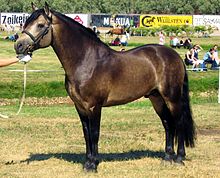stallion

A stallion (from old Germanic hang ista , exact etymology unclear) is a male of the family Equidae (Equidae) and camels (Camelidae). The female counterpart to the stallion is the mare . A stallion is a male, uncastrated animal, while a castrated stallion is called a gelding .
Horse stallion

Stallions that are not used for breeding are usually castrated (laid) to make them more sociable.
Sire or stallion
An operating in the breeding stallion stallion named because contacting a Hengst and a mare for the purpose of copulation as a ceiling is called. Only stallions registered in the so-called stallion register of the respective breed may be used for breeding in Germany . For many breeds, this requires participation in a licensing (and passing a stallion performance test ). In thoroughbred breeding, there is an official recognition procedure for this (according to racing regulations, numbers 50 to 52). Stallions that are suitable, licensed and selected for breeding are called sires .
State stallions are stallions who are set up in a state stud and are mostly state-owned. This applies to about half of all warm- blood and cold-blood breeding stallions in Germany, the remaining stallions are owned by private breeding stations. These are called private stallions (PB).
Main stallions are stallions who are set up in a main stud. In Austria, main stallions are also known as Pepinier stallions .
The performance, the character and the temperament of the potential sires were thoroughly checked as early as 1926 in the stallion testing institute Zwion / Georgenburg and the offspring trained there for one year from the age of two and a half were tested in the Trakehner area .
Stamp stallion
Stallions that constitute above-average power of heredity, the so-called arrogance, its own line are as stallions referred. The most famous stamp stallion is probably Eclipse as the most important progenitor of the English thoroughbred . Dark Ronald (1905–1928) is considered the hallmark of German thoroughbred breeding in the 20th century. In the recent past, St. Simon , Nearco and Northern Dancer should be mentioned in the international breeding of this breed (see also Championat of Sire Horses ). In warm blood horse breeding, z. B. the Trakehner temple guardian as a stamp stallion .
Web links
Individual evidence
- ^ Arnim Basche : History of the horse. Sigloch, Künzelsau 1984; 2nd Edition. Stürtz, Würzburg 1991, ISBN 3-8003-0396-5 , p. 454.
- ↑ also individual potency; see. Gustav Pusch: Textbook of General Animal Breeding , 1911 , p. 255 ff.